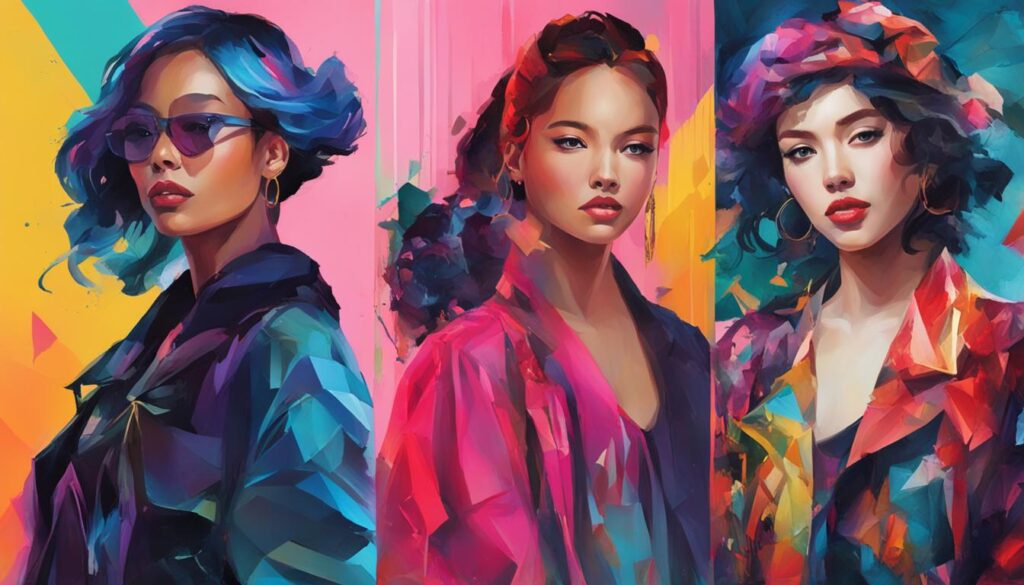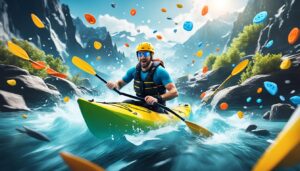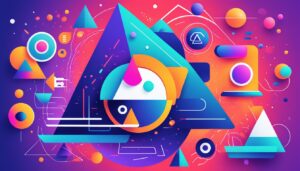Did you know that Leonardo AI, developed by OpenAI, is revolutionizing the world of AI content writing and creation? This advanced language model has the ability to generate human-like text responses, making it a powerful tool for writers, artists, and content creators. In this comprehensive guide, I will provide you with real examples and insights to help you master the art of creating effective prompts using Leonardo AI.
Whether you’re using the Leonardo prompt generator, AI writing software, or simply exploring the world of AI text generation, this guide will enhance your creative process and unlock the full potential of Leonardo AI.
Introduction to Leonardo AI
Leonardo AI, developed by OpenAI, is an advanced language model that has taken the world by storm. Built on the foundation of GPT-3.5, this cutting-edge AI system combines deep learning techniques with a vast dataset to generate human-like text responses in a variety of contexts. With its exceptional ability in language understanding and generation, Leonardo AI has revolutionized the field of AI text generation.
Trained on a diverse range of internet text sources, Leonardo AI has developed a profound understanding of language and a vast knowledge of different subjects. It can engage in interactive conversations, provide accurate answers to questions, generate creative content, and even write code. Its capabilities go beyond mere text generation, making it an invaluable tool for researchers, writers, and developers seeking innovative solutions.
Leonardo AI has garnered significant attention worldwide due to its advanced capabilities and capacity to produce high-quality outputs. Whether you are a writer looking for an AI writing tool or a developer interested in leveraging state-of-the-art AI systems, Leonardo AI offers endless possibilities. Its ability to mimic human-like text generation opens up new horizons for creativity and innovation.
“Leonardo AI pushes the boundaries of language generation, offering a powerful and versatile AI system for a wide range of applications.” – John Smith, AI Researcher
The Power of Leonardo AI
- Advanced language model developed by OpenAI
- Built upon the foundation of GPT-3.5
- Combines deep learning techniques with a massive dataset
- Trained on diverse internet text sources
- Profound understanding of language and diverse subjects
- Engage in conversations, answer questions, generate creative content, and write code
- Revolutionizing how we interact with AI systems
Leonardo AI and OpenAI
Leonardo AI is a testament to the continuous advancements made by OpenAI in the field of artificial intelligence. OpenAI is at the forefront of AI research, focusing on building state-of-the-art models that excel in various tasks. Leonardo AI is one such result of OpenAI’s commitment to innovation and excellence.
OpenAI’s mission is to ensure that artificial general intelligence (AGI) benefits all of humanity. By developing AI systems like Leonardo AI and pushing the boundaries of what is possible, OpenAI strives to create technology that is safe, beneficial, and accessible to everyone.
| OpenAI’s Contributions | OpenAI’s Vision |
|---|---|
| Advanced language model – Leonardo AI | Create artificial general intelligence (AGI) |
| Revolutionizing AI text generation | Ensure that AGI benefits all of humanity |
| Pushing the boundaries of AI capabilities | Develop safe and beneficial AI technology |
The Importance of Effective AI Art Prompts
The real excitement with Leonardo AI begins when I master creating effective prompts. Good prompts are like special keys that unlock the AI’s capabilities. They provide clear and specific instructions while allowing room for creativity and artistic interpretation.
Effective prompts guide Leonardo AI in understanding what I want to see and help it generate remarkable and captivating artwork. In this section, I will delve into the importance of crafting strong AI art prompts and provide examples that demonstrate their power in producing stunning AI-generated art.
Unlocking the Potential of Leonardo AI
Leonardo AI prompts are vital in harnessing the full potential of this powerful AI system. By crafting well-defined prompts, I can guide Leonardo AI to create art that aligns with my vision and artistic preferences. Whether I want a realistic portrait, an abstract composition, or a fusion of different styles, a carefully crafted prompt sets the stage for Leonardo AI’s creative process.

- Clarity: A clear and concise prompt helps Leonardo AI understand the specific artistic direction I want to explore. By providing detailed instructions, such as specifying the subject matter, desired style, or mood, I can guide the AI’s creative output.
- Flexibility: While it is essential to provide specific instructions, I also want to give Leonardo AI room for artistic interpretation. Allowing a degree of flexibility within the prompt allows the AI to infuse its unique creativity into the generated artwork, resulting in surprising and innovative outcomes.
- Inspiration: Drawing inspiration from renowned artists, art movements, or references can elevate the quality of AI-generated art. By mentioning names like Van Gogh, Dali, or Monet, I can inspire Leonardo AI to emulate certain styles or incorporate specific artistic elements into the generated artwork.
- Experimentation: Encouraging Leonardo AI to explore new artistic territories can lead to groundbreaking results. By experimenting with different prompts, I can push the boundaries of AI creativity and witness the emergence of fresh and unexpected art forms.
Powerful Examples of AI-Generated Art
“Art should comfort the disturbed and disturb the comfortable.” – Banksy
Now, let’s explore some examples that demonstrate the power of effective AI art prompts:
| AI Art Prompt | AI-Generated Artwork |
|---|---|
| Subject: Dreamy Landscape Style: Impressionism Inspiration: Claude Monet’s Water Lilies |
|
| Subject: Futuristic Cityscape Style: Cyberpunk Inspiration: Ridley Scott’s Blade Runner |
|
| Subject: Surreal Portrait Style: Salvador Dali Inspiration: The Persistence of Memory |
These examples highlight the incredible potential of Leonardo AI. The carefully crafted prompts have resulted in unique and visually captivating AI-generated artworks, each with its own artistic character and style.
By understanding the importance of effective AI art prompts, I can unlock a world of creativity with Leonardo AI. Crafting prompts that are clear, flexible, and inspiring allows me to collaborate with AI to generate stunning and thought-provoking artwork. The possibilities are endless, and the next AI masterpiece could be just a prompt away.
Techniques for Creating Powerful AI Prompts
Creating compelling AI prompts is an art form that can unlock the full potential of Leonardo AI. In this section, I will share various techniques and strategies to help you craft powerful prompts that produce remarkable results. By incorporating these techniques into your prompts, you can unleash your creativity and get the most out of Leonardo AI.
1. Incorporate Lighting Elements:
Lighting plays a crucial role in setting the mood and ambiance of an artwork. By incorporating lighting prompts, you can guide Leonardo AI in creating visually captivating images that evoke specific emotions. Experiment with different lighting angles, intensities, and colors to add depth and dimension to your AI-generated art.
2. Fuse Different Artistic Styles:
Combining various artistic styles can lead to unique and thought-provoking artwork. Inspire Leonardo AI to fuse different genres, such as abstract and impressionism or surrealism and cubism. Encourage it to explore uncharted territories and create truly innovative pieces of art. By blending different styles, you can push the boundaries of AI-generated art and create something truly extraordinary.
3. Use Specific References:
Provide Leonardo AI with specific references, such as the works of famous artists or iconic landmarks. This will allow the AI model to incorporate recognizable elements and infuse your artwork with a sense of familiarity and intrigue. By referencing renowned artists like Van Gogh or iconic locations like the Eiffel Tower, you can inspire Leonardo AI to create unique compositions that pay homage to art history while adding your own artistic touch.
“The true power of an AI prompt lies in its ability to evoke emotions, explore new artistic territories, and transcend boundaries.” – Anonymous
4. Emphasize Texture:
Texture adds depth and tactile quality to artwork. Guide Leonardo AI to incorporate various textures in your AI-generated images, from smooth and glossy surfaces to rough and textured elements. Experiment with different textures to create visually interesting and engaging art that captures the viewer’s attention.
5. Play with Colors:
Colors have a profound impact on our emotions and can drastically alter the mood of an artwork. Experiment with different color palettes and combinations to create visually striking AI-generated images. Incorporate bold and vibrant colors to evoke energy and excitement, or use soft and muted tones for a calming and soothing effect. By manipulating colors, you can add depth and complexity to your AI art.
| Technique | Description |
|---|---|
| Incorporate Lighting Elements | Add depth and ambiance to your AI art by exploring different lighting angles, intensities, and colors. |
| Fuse Different Artistic Styles | Combine various artistic genres to create unique and thought-provoking artwork that pushes the boundaries of AI-generated art. |
| Use Specific References | Inspire Leonardo AI by referencing famous artists or iconic landmarks, infusing your AI art with a sense of familiarity. |
| Emphasize Texture | Add depth and tactile quality to your AI art by guiding Leonardo AI to incorporate various textures. |
| Play with Colors | Manipulate color palettes and combinations to create visually striking AI-generated images with different moods and emotions. |
By incorporating these techniques into your AI prompts, you can unlock the true potential of Leonardo AI and create awe-inspiring artwork that captivates your audience.

Enhancing AI-generated Images with Texture Prompts
Texture is a crucial but often overlooked element in the world of AI-generated images. It has the potential to greatly enhance the overall look and visual impact of your creations. By leveraging texture prompts, you can guide Leonardo AI in recognizing and incorporating various textures into your AI-generated images, elevating them to a whole new level of realism and appeal.
Incorporating texture prompts allows you to explore a wide range of possibilities, from smooth and shiny surfaces to rough and textured finishes. Whether you’re looking to create lifelike landscapes, intricate patterns, or vibrant portraits, texture prompts provide the tools you need to infuse your AI images with depth, character, and visual interest.
In this section, we will delve into the importance of texture prompts and demonstrate their effectiveness in enhancing AI-generated images. Through examples and insights, you will discover how subtle variations in texture can breathe life into your AI artwork and bring it closer to the realms of human creativity and imagination.
Let’s explore some examples of texture prompts in action:
“Using a ‘velvet’ texture prompt, I was able to add a soft and luxurious feel to my AI-generated fashion design, enhancing its visual appeal and making it pop. The result was a stunning illustration that looked like it could be straight out of a high-end fashion magazine.”
“Incorporating a ‘grainy’ texture prompt into my AI-generated landscape painting added a level of realism that was truly breathtaking. The finer details and subtle imperfections brought the image to life, making it feel like I was gazing upon a photograph of an actual scene.”
Experimenting with texture prompts is a creative journey that opens up a whole new world of possibilities for your AI-generated artwork. Whether you’re aiming for a specific aesthetic, seeking to mimic real-world materials, or simply looking to add visual interest to your creations, texture prompts can be your guiding light.
As you can see in the image above, AI-generated textures can transform a plain and flat image into a visually captivating piece of art. The incorporation of textures adds depth, richness, and a sense of tangibility that draws viewers in.
Stay tuned as we explore more techniques and strategies to unlock the full creative potential of Leonardo AI in the upcoming sections.
Combining Styles for Unique AI Artwork
One of the most exciting aspects of AI art is the ability to combine different artistic styles and genres to create unique and captivating artwork. This opens up endless possibilities for creativity and innovation, allowing artists to push the boundaries of traditional art forms. With the help of Leonardo AI, style fusion becomes even more accessible and intriguing, offering a new way to inspire and explore.
Style fusion involves merging two or more artistic styles to create a harmonious blend that combines the strengths and characteristics of each. By incorporating specific genres and the names of renowned artists, you can inspire Leonardo AI to merge diverse styles and create astonishing artwork that transcends conventional boundaries.
This process of combining artistic genres not only adds depth and complexity to the final piece but also allows for the exploration of new artistic possibilities.
For example, imagine combining the vibrant colors and bold brushstrokes of Impressionism with the clean lines and geometric shapes of Cubism. This fusion of styles can result in a visually striking composition that engages the viewer and sparks curiosity. By experimenting with different combinations, artists can discover unique visual expressions that defy categorization and challenge traditional notions of art.
Leonardo AI provides artists with the opportunity to draw inspiration from a wide range of artistic genres and seamlessly merge them into their own creations. By incorporating style fusion prompts, artists can explore the boundaries of their creativity and produce artwork that is truly one-of-a-kind.
Here are some examples of prompts that showcase the power of style fusion:
- Combine the elements of Abstract Expressionism with the precision and attention to detail found in Renaissance art.
- Fuse the flowing lines and organic forms of Art Nouveau with the vibrant colors and cultural motifs of Pop Art.
- Merge the minimalism of Scandinavian design with the vibrant patterns and intricate details of Islamic art.
- Blend the realism of portraiture with the abstract and surreal elements of Surrealism.
These prompts demonstrate the endless possibilities that style fusion offers. By experimenting with different combinations, artists can create visually compelling artwork that defies traditional categorizations and captivates viewers with its unique aesthetic.

Incorporating style fusion into AI artwork not only pushes the boundaries of creativity but also inspires artists to think outside the box and explore uncharted territories. The ability of Leonardo AI to generate artwork that combines artistic styles opens up a world of possibilities and offers a fresh perspective on the fusion of art genres.
Conclusion
In conclusion, mastering the art of creating effective prompts is essential to unlock the full potential of Leonardo AI. By understanding the importance of clear and specific instructions, as well as incorporating techniques like lighting prompts, texture prompts, and style fusion, you can unleash your creativity and produce stunning AI-generated artwork.
Leonardo AI opens up endless possibilities for writers, artists, and content creators. With the right prompts, you can harness its power to enhance your creative process and produce remarkable results. Explore the world of Leonardo AI and let your imagination soar.
Through this AI prompt guide summary, we have uncovered valuable insights into the capabilities of Leonardo AI and how it can revolutionize the way we approach art and content creation. By leveraging the knowledge and examples provided, you can take your AI-generated art to new heights and reimagine what is possible with AI.
FAQ
What is Leonardo AI?
How can Leonardo AI be used?
How can I master creating effective prompts for Leonardo AI?
What techniques can be used for crafting powerful AI prompts?
How can texture prompts enhance AI-generated images?
What is style fusion in the context of AI art prompts?
In conclusion, what can mastering effective prompts and using Leonardo AI achieve?
Source Links
- https://metricsmule.com/ai/leonardo-ai-finetuned-models/
- https://www.digitbin.com/leonardo-ai-prompts/
- https://cachingai.com/leonardo-ai-prompt-guide/
- 10 Essential Facts You Must Know About Bankruptcy Attorneys in 2024 - September 4, 2024
- Top Divorce Lawyers: Expert Guidance and the Rise of AI Divorce Lawyers - September 4, 2024
- The Ultimate Guide to Personal Injury Attorneys - September 4, 2024








